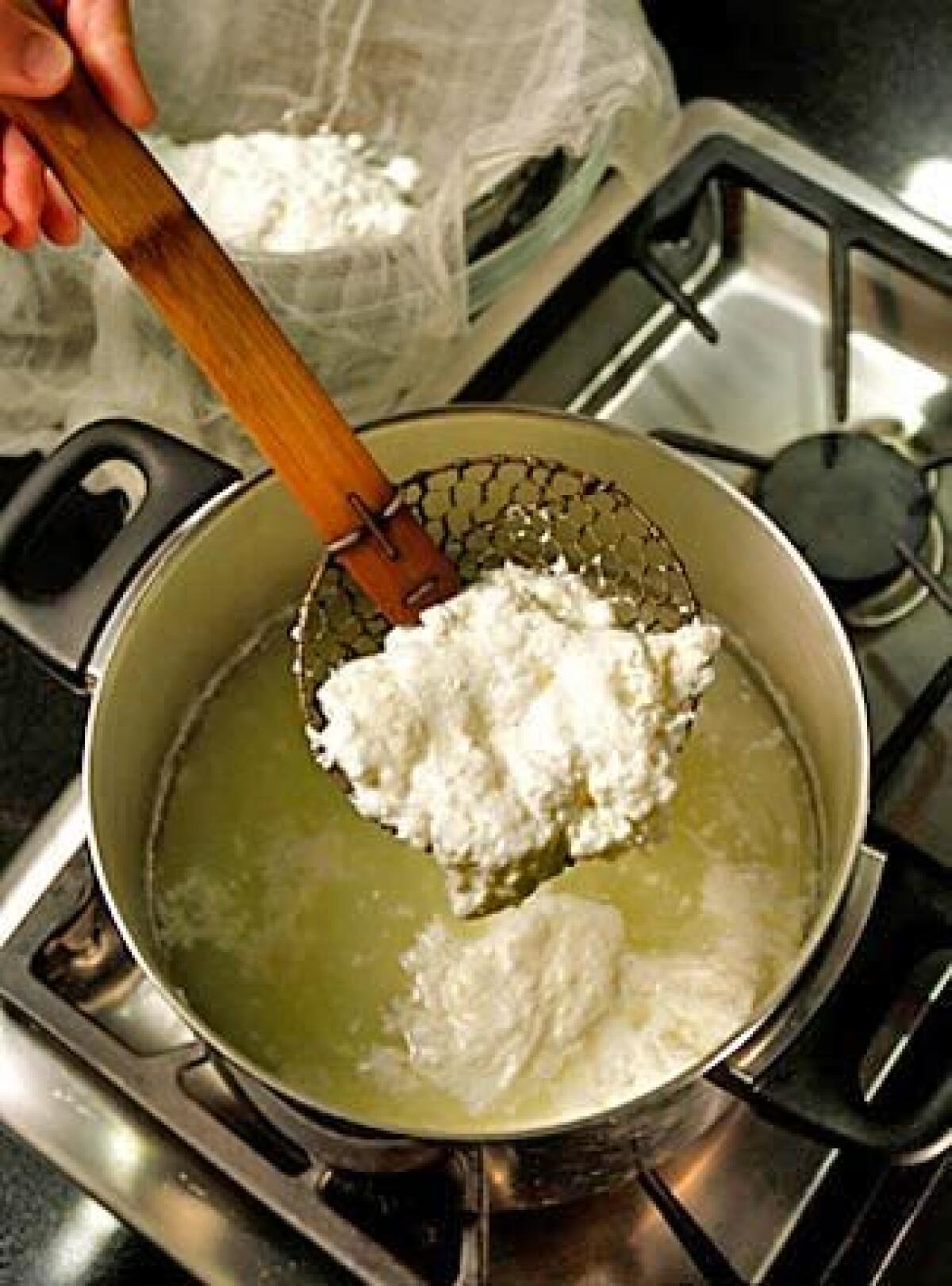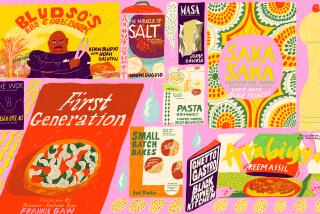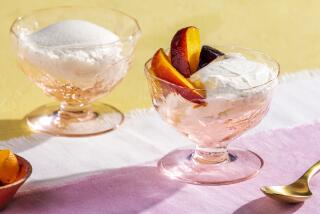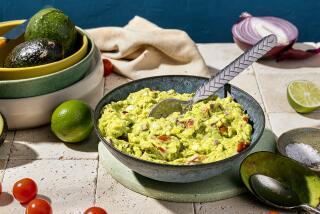The California Cook: Homemade ricotta -- itâs easier, and better, than you think

When it comes to most things around the house, Iâm about the most unhandy guy youâve ever seen. I canât hang a picture straight. But when it comes to cooking, I go a little do-it-yourself crazy. The last couple of weeks Iâve been making my own ricotta. Before you dismiss this as just another wacky fad, trust me â youâve got to give it a try.
It doesnât require any special equipment, and you can find all of the ingredients at your neighborhood grocery. And the results are so much better than almost any commercial ricotta you can buy that you wonât believe itâs the same stuff. This is ricotta you can â and maybe should â eat by itself.
Hereâs all you have to do to make it: Warm a mixture of whole milk and buttermilk over medium heat until it reaches about 185 degrees (youâll see a ring of bubbles appear around the inside of the pan). Remove the pan from the heat and stir in vinegar (regular old distilled white ⌠the stuff you probably now use for washing windows). Let it stand about 5 minutes until curds form, then gently lift them off with a slotted spoon and drain in a strainer.
Thatâs it, fresh cheese that takes less than 45 minutes to make. What could be more simple? And itâs kind of wonderful the way it comes together, that everyday sort of kitchen magic that makes cooking something new so much fun.
Recipes: Homemade ricotta, roasted peppers stuffed with homemade ricotta and ricotta-honey gelato with orange.
But how does it taste? Honestly, I was a little skeptical at first. I mean, outside of some really great stuff Iâve had in Italy, Iâd always thought ricotta was meant to be kind of bland, so how much better can bland be?
Short answer: Lots. Honestly, this ricotta is so good it can be used as a starring ingredient, not just asthe paste that holds together lasagna. The flavor is delicate with a wonderfully milky combination of sweet and tang.
And itâs so easy to make, I donât think Iâll be buying the packaged stuff again, outside of an emergency.
What do you do with homemade ricotta? How about spooning a mound in the center of a platter, drizzling it with good olive oil and seasoning it with sea salt and coarsely ground black pepper. Surround it with toasted bread slices and maybe some grilled eggplant, zucchini or peppers.
For dessert, do the same thing, but drizzle with honey instead of oil and serve it with fresh berries or cut-up late-summer fruit (fresh figs are amazing right now), with sliced toasted almonds scattered over top.
If you need a main course, mix ricotta with some chopped fresh herbs, spoon it onto a square of cooked fresh pasta, lay another square on top and drizzle everything with sage butter. Instant lasagna. If you donât have enough time, simply use the herbed ricotta to dress al dente dried pasta shapes such as penne or orecchiette.
After playing with it for a while (Iâve had lots of ricotta in my refrigerator the last month), Iâd say that the more restrained the combination, the better with this stuff. One of my favorite dishes was a lightly herbed mixture used to stuff roasted and peeled red and yellow bell peppers.
Or, based on how amazingly good fresh ricotta is with honey, try making gelato with ricotta, honey and a little orange liqueur. Youâll need to add a little milk and cream to keep the mixture from being chalky, but not so much as to obscure the ricotta flavor (itâll still have a little of that texture ⌠think of cannoli filling).
And those are just a few ideas of many.
Now there are those who will tell you that this cheese isnât truly ricotta. And pedantic though they may be, Iâm afraid theyâre right. True ricotta is poverty food intended to wring the last bits of protein from milk by reheating the whey thatâs left from making another cheese (hence the name ricotta â or recooked). And if you have a lot of whey laying around, you certainly should try it that way.
Otherwise, youâre better off with this shortcut method, which may be less than totally authentic but is certainly totally delicious.
Essentially what happens is that heating the milk changes the nature of the proteins and they begin to stick together, or coagulate. Adding acid further coagulates the proteins â itâs not unlike what happened when you were a kid and poured orange juice into your cereal milk at breakfast.
You gently spoon this moist mass of curds out of the pot (I use a Chinese âspiderâ skimmer) and set them in a cheesecloth-lined strainer to drain for five minutes, and youâve got ricotta. Whatâs left behind in the pot is the greenish-gray whey, which, if youâre in a particularly traditional frame of mind, you can feed to your prosciutto pigs.
As you might guess, with a process so simple, there is ample room for variation. I spent a couple of weeks trying as many as I could find and after many, many gallons of milk, I think Iâve come up with a version that combines the best of all of them.
The first variable is the milk itself. You can make ricotta with whole milk or skim milk, and with the addition of whipping cream or buttermilk. I even tried it with goatâs milk (the best ricotta Iâve ever tasted was made from sheepâs milk; commercial American goatâs milk is not worth the effort).
For the acidification, you can use lemon juice, vinegar or buttermilk. (I also tried a recipe using vegetable rennet as the coagulant, but Iâm afraid that level of cheese-making must be just a bit beyond me.)
Or you can use a combination. Thatâs what I wound up with. There is enough acidity in buttermilk that you can use just that and whole milk to make ricotta, but you have to use a lot of buttermilk (2 cups for a half-gallon of milk). While that buttery flavor is nice, it becomes a little too strong in that concentration.
Regular old distilled white vinegar also works well, but the result is a little bland. Lemon juice works fine, but the acidity will vary depending on the season and so itâs a little unreliable. So I compromised, using both 1 cup of buttermilk and 21/2 tablespoons of vinegar to make a ricotta that has a delicate but not overpowering lactic tang.
Temperature is another variable. After cooking ricottas to 165, 175, 180, 185 and 190 degrees, I found that the higher the temperature, the greater the amount of cheese youâre able to pull from the whey. On the other hand, once the temperature gets to about 190, the milk solids that stick to the bottom of the pan begin to caramelize and scorch, making them so sticky it takes a lot of scrubbing to clean the pot.
In my laziness, I decided to settle for a smidgen less cheese in exchange for much easier clean-up. At 185 degrees, 10 cups of milk makes about 2 cups â or 1 pound â of cheese. Thatâs plenty.
Finally, how long you let the cheese stand in the strainer will affect the final texture. The longer it goes, the drier and firmer the curds will be. For me, the sweet spot came after about 5 minutes, when there is still enough moisture in the cheese that it oozes slightly, but the curds have begun to firm up.
At this point, you may well be tempted to eat the ricotta straight out of the strainer, and indeed, there is something incredibly luxurious about eating spoonfuls of the warm curds, sprinkled with just a little salt and pepper.
More to Read
Eat your way across L.A.
Get our weekly Tasting Notes newsletter for reviews, news and more.
You may occasionally receive promotional content from the Los Angeles Times.











